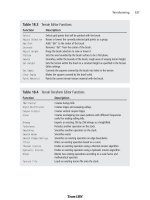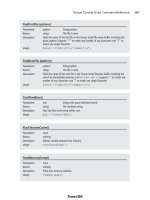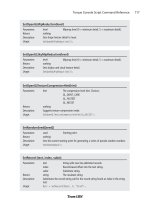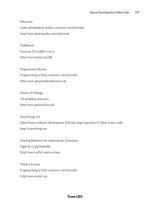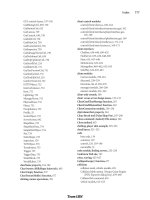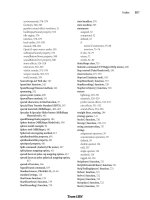52909 horses the graceful friends all in one lesson plan
Bạn đang xem bản rút gọn của tài liệu. Xem và tải ngay bản đầy đủ của tài liệu tại đây (240.1 KB, 4 trang )
Strong and Graceful
ANIMAL FRIENDS
The horse has been a friend to human beings for thousands
of years. Long ago horses were used to carry soldiers onto
the battlefield. They have also pulled carriages, carts, and
heavy farm machinery. Today people ride horses and use
them for hunting, playing polo, and racing. Horses even perform in circuses.
The reason horses have been used in so many ways is that they are large and strong. A typical horse
weighs more than 1,000 pounds! It may sound more than 5 feet tall at the shoulders. From its nose to
its tail, it’s about 9 feet long.
The legs of a horse are strong even though they look very slender. When a horse is moving, the back
legs give it the power to move forward, and the front legs give it support.
A horse’s foot is really just one large toe, and the hoof is like a thick toenail. The part of the hoof that
can be seen when the horse’s feet are on the ground is called the “wall”. Horseshoes are fitted on the
underpart of the wall to protect it from cracking.
A horse’s eyes are larger than those of any other land animal. But horses have a problem with sight. A
horse sees things first with one eye and then with the other. So even small stationary objects appear
to leap. This frightens the horse. To keep the horse calm, the owner fits pads called blinders, or
blinkers, on the outer sides of the eyes. This prevents the horse from seeing things that might frighten
it.
Reading Comprehension
Please answer the following questions and give your answers in full sentences
1.
What has made horses a good friend to humans?
2.
Why have horses been used in many ways?
3.
Why is it necessary to use blinkers?
4.
How much does an average horse weigh?
Did you know?
Note:
Feet is a unit for measuring height i.e. 9ft = 2.7432m
Pound is a measurement of mass/weight i.e. 1000lb = 453kg
Ref: My first Britannica – Mammals pg 40-41
Horses can sleep both lying down and
standing up and because their eyes are
on the side of their head, they are
capable of seeing nearly 360 degrees
at one time.
Can you match the meaning with the words?
Hoof
Leap
Stationary
Crack
Battlefield
Cart
Slender
Blinder/blinker
Carriage
Horseshoe
The land or place where a war/battle takes place
A four-wheeled passenger vehicle pulled by two or more horses
An open vehicle, typically used for carrying loads and pulled by a horse.
(describing body parts) long and elegantly (stylish) thin
The horny part of the foot of an a horse
An iron shoe for a horse, in the form of a semi-circle and secured to the hoof,
Break or cause to break without a complete separation of the parts
Not moving
A powerful jump or quick movement
A pair of leather shades that prevent horses seeing sideways and behind.
C____________
C_______________
Bridle
Listening
Ref: My first Britannica – Mammals pg 40-41
The horse has been a friend to human beings for t__________ of years. Long ago horses were used to
carry soldiers onto the b__________. They have also pulled carriages, carts, and heavy farm m___________.
Today people r__________ horses and use then for h__________, playing polo, and racing. Horses even
perform in c_____________.
The reason horses have been used in so many ways is that they are large and strong. A t_________ horse
weighs more than 1,000 pounds! It may be more than 5 feet tall at the shoulders. From its nose to its
tail, it’s about 9 feet long.
The legs of a horse are strong even though they look very s___________. When a horse is moving, the
back legs give it the power to move f___________, and the front legs give it support.
A horse’s foot is really just one large t____, and the h____ is like a thick toenail. The part of the hoof
that can be s_______ when the horse’s feet are on the g_______ is called the “wall”. Horseshoes are fitted
on the u__________ of the wall to protect it from c__________.
A horse’s eyes are larger than those of any other l_____ animal. But horses have a problem with sight.
A horse sees things first with one eye and then with the other. So even small s_________ objects
a___________ to leap. This frightens the horse. To keep the horse c_________, the owner fits pads called
blinders, or b__________, on the outer sides of the eyes. This p_________ the horse from seeing things that
might frighten it.
Speaking
Is it wrong to eat horsemeat? Why?
Recently, in Britain, there was a big scandal when Horse DNA has been found in beef burgers that are
sold by supermarkets. Public was outraged. And now, the U.S. Department of Agriculture is talking
about approving a horse slaughterhouse in New Mexico and Americans are strongly against it.
On the other hand, horsemeat is popular in many countries like France, China, Kazakhstan, Indonesia,
Germany, Belgium and Switzerland.
Do people eat horsemeat in your country? What do you think about eating horsemeat? Would you try
it? There is no health risk in eating horsemeat, so why do you think people are against the idea of
eating it? If you can eat pig, why not horse? Is it right to differentiate animals i.e. cats and dogs are
loved and cared while some animals, like chickens are kept in tiny cubicles with no freedom waiting
to be slaughtered.
First discuss in pairs and then share your opinions with your teacher and the rest of the class.
Writing
Ref: My first Britannica – Mammals pg 40-41
The article you studied is from British Encyclopaedia. Encyclopedia is a book or set of books
giving information about many subjects and typically arranged alphabetically. You may
consider it as a more detailed dictionary. They are informative and not subjective. They do
not give personal opinions but facts. They typically have subsections.
In this lesson, you are asked to write an encyclopedic entry. Here are some tips;
•
•
•
Create an outline for your article. Make a list of sub-headings to write about. For each
sub heading, create bullet-points of information/facts
The paragraphs should start generic and then outline details.
Avoid personal pronouns
Ref: My first Britannica – Mammals pg 40-41
